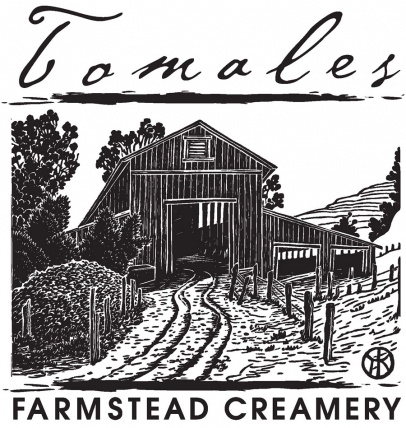Make Your Summer Sparkle with Tomales Farmstead Creamery and Heidrun Meadery
It wasn’t a lack of other things to do that led David Jablons and Tamara Hicks to purchase Toluma Farms in 2003 and set about restoring the 160-acre property for goat and sheep dairy operations. Tamara is a clinical psychologist practicing in San Francisco; David is a professor and chief of thoracic surgery at UCSF and the program leader of thoracic oncology. And at the time, the couple’s daughters were ages 4 and 8.
In 2013, David and Tamara added a creamery operation, Tomales Farmstead Creamery, to the Animal Welfare Approved farm located two miles outside the town of Tomales. Tomales Farmstead Creamery currently produces five different cheeses under the direction of head cheesemaker, Ashley Coffey. All five have been given Miwok names that reflect the heritage of the coastal region. The cheeses include Liwa, meaning “water,” which is a three-day fresh farmer’s goat milk cheese; Atika, meaning “two,” a mixed sheep and goat milk cheese that is aged three to nine months; and Assa, meaning “woman,” a goat milk cheese that is also aged three to nine months.
My two personal favorites are Kenne and Teleeka. Kenne, meaning “one,” is a pasteurized soft ripened goat milk cheese that is made solely with milk produced on the farm. Aged three weeks, it has assertive mushroomy and earthy aromas with a moist cakey paste. The cheese has a pale straw color with a natural wrinkled rind formed due to Geotrichum mold.
Teleeka, meaning “three,” is a pasteurized soft ripened mixed milk cheese (50% cow, 30% goat and 20% sheep). The cow milk comes from their neighbors at Marshall Home Ranch and Dairy. Teleeka has a bloomy rind and well-rounded flavors, reminiscent of Italy’s three-milk La Tur.
Warmed to room temperature, both Kenne and Teleeka become nice and gooey, spreading easily on a baguette.
An ideal pairing with both of these cheeses would be a sparkling mead from one of Toluma Farms’ fellow West Marin neighbors, Heidrun Meadery.
Heidrun meads are made in the traditional French méthode champenoise through the fermentation of varietal honeys like Point Reyes Wildflower, Madras Carrot Blossom and Hawaiian Macadamia Nut Blossom. Proprietor and head meadmaker Gordon Hull works hard to produce a “hands-off” finish to his dry, crisp and delicious meads that allows the nuances of each honey varietal to shine through. If you think you don’t like mead, I encourage you to try one of Heidrun’s modern takes on the ancient nectar of kings.
[For more on Heidrun Meadery, read http://ediblemarinandwinecountry.ediblecommunities.com/drink/thoroughly-modern-mead.]
I was initially drawn to the Tomales Farmstead cheeses because of their beautiful label. When I asked Tamara about its genesis, I was so charmed by her story we wanted to share it with you, in her own words. The serendipity of the art, and the generosity of the artist, are reminders of the great value of living in community:
When we were thinking about designing a label, I went to the California Cheese Guild’s website to see what would be different. I noticed that most everyone had a dairy animal, or perhaps a tree. Nobody had a barn, and since our hay barn is the heart and soul of our farm, this was an easy choice. The barn was the building in the best shape when we purchased the property 14 years ago. We have given it some TLC with a new roof, day lighting and front siding, but mostly it is the same as it has been since probably the ’30s or ’40s.
But David and I love good art, so we didn’t just want a photo of the barn on the label.
Honest to god, I was sitting in our farmhouse admiring a Tom Killion print that we had purchased, and it was one of those rare moments when you have the most perfect idea. We are strong believers in keeping everything local, so I mustered up the courage to call Tom. I had been to his open studios and purchased a couple of his prints, but we didn’t know him personally at the time. When I spoke to him, he clearly stated that he doesn’t do commercial work. I said OK, and we continued to chat about West Marin, what we do at our farm and his daughter’s love for animals. He has such a love for West Marin that by the end of the conversation he said he would come for a visit, but it still wasn’t likely that he would produce a piece for our label. He came out within a few days. When he arrived he asked what I was thinking of and I pointed to the barn. He stared at it for a bit, said “just a minute,” and went to his car. I wondered if he was going to leave! He came back with a sketch pad and pencil and right then and there sketched it out. He left saying that he would play around with his sketch, send me the design and we could see if it would work for a label. A week later he sent me his design that would then become a wood-block print and we said ABSOLUTELY!!
I love this story because it perfectly captures why we love doing what we do. For generations, people of West Marin have cared so much about the land and the people on the land that they have gone to great lengths to protect it and support their neighbors. Tom is a perfect example of one of these incredible individuals. He didn’t come out because of money; he came and designed the art for our label because he cares about protecting agriculture and open space in West Marin. After he completed the block print, Maureen Kringen, who designed our website a decade ago and lives in Sebastopol, created the label.





